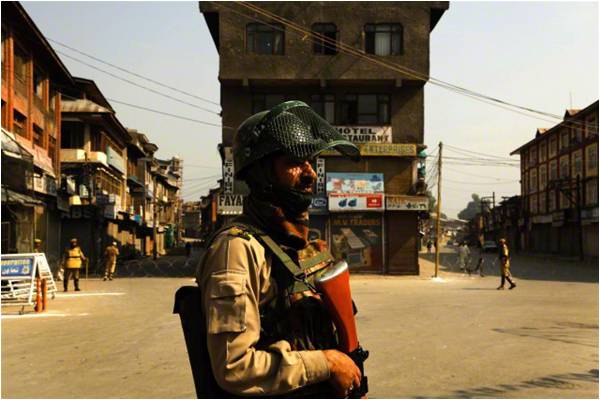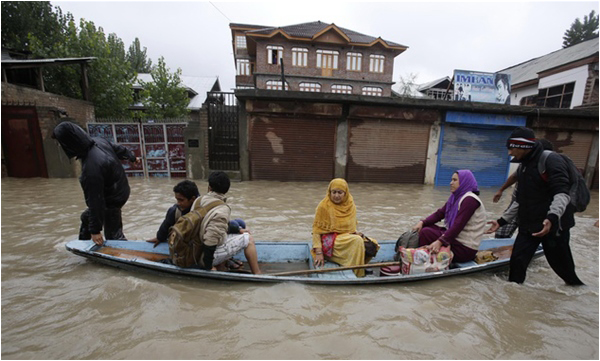
A year after the devastating floods in Kashmir, there has hardly been any recovery, both at the psychological and infrastructure level. On Monday, the entire state shut down against the Indian government’s apathy, and also to remember those who lost their lives. They also celebrated the collective valour and compassion exhibited during those testing times, when the government had completely failed. It is a different issue that then chief minister Omar Abdullah, who also happens to be the president of the National Conference, donated blood and supported the strike call given by the Kashmiri traders. Separatist organizations also supported the call. That is Kashmir’s irony – when you are in power, you don’t deliver, and when you are out, you cry hoarse.
While Kashmir has shown exemplary resilience in standing up again, there are many lessons that the flood has raised. But we have the tendency to ignore such questions and move on. We are an emotional people and get fooled easily. The September floods had come after a century and the magnitude of the tragedy was huge. But it was not a normal Kashmir that faced this wrath of rain and water. Kashmir has suffered a lot since 1990. That, perhaps, is the reason that we were able to show such resolve. As the youth of Kashmir showed us how the catastrophe could be dealt with without any resources at hand, it is undoubtedly the difficult times we have been through that gave us the strength.
A year later, there have hardly been any serious efforts to rehabilitate the people who lost everything. Many families are still living in tin sheds. As people recall the horrific experiences of the flood, they are also reminded of the false promises made by the Government of India regarding their rehabilitation. Prime Minister Narendra Modi had called the Kashmir floods a “national-level disaster”, signaling liberal financial assistance to the state government for the relief and rehabilitation of the victims. But New Delhi continues to drag its feet on the promised rehabilitation package. The reluctance of the Modi government has not gone down well with the people of Kashmir.
Successive governments in New Delhi have repeatedly failed the people of Kashmir, resulting in a deep-rooted sense of alienation in the valley. We have been hearing a lot about the need to address this trust deficit. But in the hour of need, there was no monetary assistance. When cyclones and other such calamities hit other parts of India, financial assistance is not usually an issue.
The failure of the Indian government to release a rehabilitation package was preceded by the failure of the state government to avert the disaster in the first place. In fact, people had started blaming the government immediately. The widespread damage caused by the floods brought to light the absence of a proper disaster management mechanism. Though it is not possible to avert all natural disasters, there is scope for minimizing the damage.\

As the NC led government failed to provide first aid to the victims, the PDP-led government has done no wonders either. While it is ruling in coalition with the BJP, which is also in power at the centre, its failure to get a decent relief package cannot be justified. The ‘Agenda of Alliance’, which the two coalition partners had vowed to follow, seems to have been thrown into the dustbin. It is not clear if the Modi government is deliberately trying to fail the state government, or it is the incompetence of latter that no tangible relief work has been been done.
Successive governments have failed to act proactively, and that is why the state was not well prepared to deal with a natural disaster. A comprehensive strategy should have been in place to face any exigency in a coordinated manner. Preparedness, prediction and prevention of disasters is even more important in a place like Kashmir, which is vulnerable to natural calamities like earthquakes, floods, snowstorms, landslides and cloudbursts. A fool proof mechanism for rescue, relief and rehabilitation of the victims of such disasters needs to be put in place. At least the administration needs to be alert round the year. A year after the devastating floods, the state government is yet to begin basic work on preventing natural calamities.
The de-silting of Jhelum and other water bodies should have been the first thing any government should have done after the flood. But all we hear is that tenders have been issued. The drainage system also remains choked. If such simple tasks cannot be carried out in a timely manner, one cannot expect a major rehabilitation project. And that is why the anger of the traders, which they registered by calling a strike, is justified.
However, putting the entire onus on the government is not the best way forward. After all, the river Jhelum had not caused so much destruction in decades. What happened in September 2014? What made the valley so vulnerable to flooding? What were the other factors that snowballed the size and ferocity of the Kashmir flood? Apart from official negligence, public apathy towards the environment was a major factor contributing to the natural disaster. From encroachments to unabated pollution and the subsequent shrinking of water bodies, people are guilty in many ways. It is important to underline the responsibility of the people, who need to be cautious when thinking of encroaching on sensitive areas. The civil society should also play its role in sensitizing people about the dangers that loom large in the wake of such attitude.
One can hope that New Delhi also comes out of the slumber and treats the flood victims as human.
The author is a veteran journalist from Srinagar
While Kashmir has shown exemplary resilience in standing up again, there are many lessons that the flood has raised. But we have the tendency to ignore such questions and move on. We are an emotional people and get fooled easily. The September floods had come after a century and the magnitude of the tragedy was huge. But it was not a normal Kashmir that faced this wrath of rain and water. Kashmir has suffered a lot since 1990. That, perhaps, is the reason that we were able to show such resolve. As the youth of Kashmir showed us how the catastrophe could be dealt with without any resources at hand, it is undoubtedly the difficult times we have been through that gave us the strength.
Many families are still living in tin sheds
A year later, there have hardly been any serious efforts to rehabilitate the people who lost everything. Many families are still living in tin sheds. As people recall the horrific experiences of the flood, they are also reminded of the false promises made by the Government of India regarding their rehabilitation. Prime Minister Narendra Modi had called the Kashmir floods a “national-level disaster”, signaling liberal financial assistance to the state government for the relief and rehabilitation of the victims. But New Delhi continues to drag its feet on the promised rehabilitation package. The reluctance of the Modi government has not gone down well with the people of Kashmir.
Successive governments in New Delhi have repeatedly failed the people of Kashmir, resulting in a deep-rooted sense of alienation in the valley. We have been hearing a lot about the need to address this trust deficit. But in the hour of need, there was no monetary assistance. When cyclones and other such calamities hit other parts of India, financial assistance is not usually an issue.
The failure of the Indian government to release a rehabilitation package was preceded by the failure of the state government to avert the disaster in the first place. In fact, people had started blaming the government immediately. The widespread damage caused by the floods brought to light the absence of a proper disaster management mechanism. Though it is not possible to avert all natural disasters, there is scope for minimizing the damage.\

As the NC led government failed to provide first aid to the victims, the PDP-led government has done no wonders either. While it is ruling in coalition with the BJP, which is also in power at the centre, its failure to get a decent relief package cannot be justified. The ‘Agenda of Alliance’, which the two coalition partners had vowed to follow, seems to have been thrown into the dustbin. It is not clear if the Modi government is deliberately trying to fail the state government, or it is the incompetence of latter that no tangible relief work has been been done.
Successive governments have failed to act proactively, and that is why the state was not well prepared to deal with a natural disaster. A comprehensive strategy should have been in place to face any exigency in a coordinated manner. Preparedness, prediction and prevention of disasters is even more important in a place like Kashmir, which is vulnerable to natural calamities like earthquakes, floods, snowstorms, landslides and cloudbursts. A fool proof mechanism for rescue, relief and rehabilitation of the victims of such disasters needs to be put in place. At least the administration needs to be alert round the year. A year after the devastating floods, the state government is yet to begin basic work on preventing natural calamities.
The de-silting of Jhelum and other water bodies should have been the first thing any government should have done after the flood. But all we hear is that tenders have been issued. The drainage system also remains choked. If such simple tasks cannot be carried out in a timely manner, one cannot expect a major rehabilitation project. And that is why the anger of the traders, which they registered by calling a strike, is justified.
The drainage system remains choked
However, putting the entire onus on the government is not the best way forward. After all, the river Jhelum had not caused so much destruction in decades. What happened in September 2014? What made the valley so vulnerable to flooding? What were the other factors that snowballed the size and ferocity of the Kashmir flood? Apart from official negligence, public apathy towards the environment was a major factor contributing to the natural disaster. From encroachments to unabated pollution and the subsequent shrinking of water bodies, people are guilty in many ways. It is important to underline the responsibility of the people, who need to be cautious when thinking of encroaching on sensitive areas. The civil society should also play its role in sensitizing people about the dangers that loom large in the wake of such attitude.
One can hope that New Delhi also comes out of the slumber and treats the flood victims as human.
The author is a veteran journalist from Srinagar

